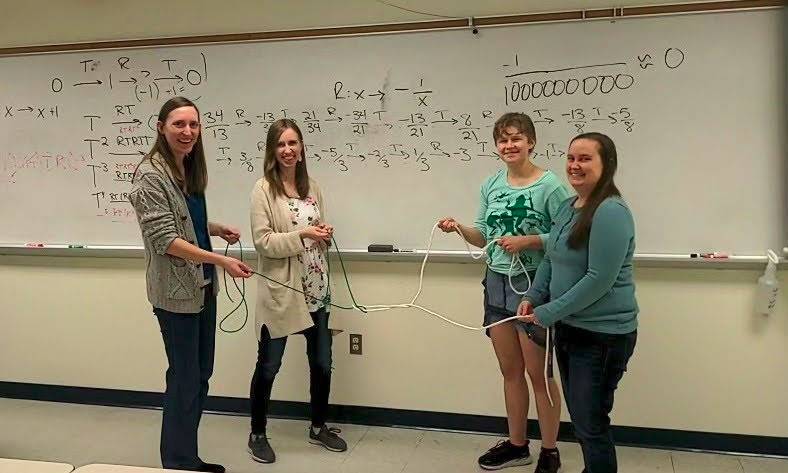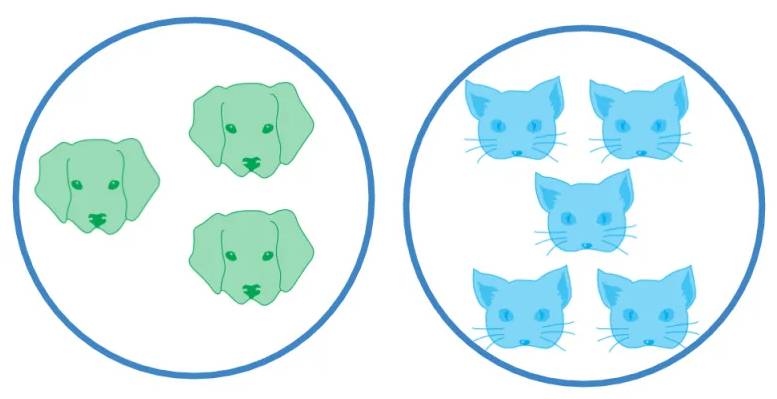Math Circles promote joyful math and build community
Imagine you have two cauldrons that are specially crafted to hold only numbers. You begin with the number “1” and place it into one of the cauldrons and then move on to the number “2” and so forth. If the sum of any two numbers in a cauldron is a third number in the same cauldron, the cauldron explodes, and you have to start all over. What is the largest number you can place in a cauldron without having it bubble over?

Professor Lora Bailey, alumna Katrina Schumaker (formerly Teunis), Lyndsey Smeyers, and Professor Lauren Keough explore rational tangles at a recent math circle.
This is a typical activity students investigate in one of the math department’s Math Circle sessions. Designed to engage students in collaborative mathematical exploration, these sessions are centered around “low floor, high ceiling problems” that invite students of any level to join in and make discoveries. Problems are typically open-ended and allow for lots of variations. For instance, what if we add a third cauldron or what if we begin with “2” rather than “1”? Lying behind these investigations is usually a rich mathematical topic that interested students can delve into. It’s not essential for students to know that the cauldron problem is related to what mathematicians call the partition problem, but it’s a great introduction for students who are ready.
Held a couple of times every semester on Friday afternoons, Math Circles bring students and faculty together in a relaxed environment that promotes curiosity and encourages participants to engage in ways that align with their interests and backgrounds. They also lead to stronger connections between students and the math department. As one recent graduate said, “I made a lot of friends through the Math Circles, and they ended up being my good friends throughout my time at Grand Valley.”
The Math Circles began in 2019 as an outgrowth of a Tensor Women and Math grant awarded to GVSU Professors Feryal Alayont and Lauren Keough, along with Professor Meghan Vandermale from Grand Rapids Community College. The goal of the grant funding was to create a mentoring program, called ISWiM (Increasing Success of Women in Mathematics), in which more experienced student mentors met with younger students and provided some professional development. The Math Circles were a fun and sustainable outcome and are now open to all students.
More recently led by Professors Lauren Keough and Lora Bailey, sessions usually see about 10-15 participants from a wide range of backgrounds. While one might assume that most would be math majors, there are in fact students from a variety of disciplines, such as biology and statistics. Some students are in their first year while others are juniors or seniors.
Another example of a Math Circle activity is a two-player game called Puppies and Kittens. Suppose you have a certain number of puppies and a certain number of kittens. Players alternate turns in which they adopt some pets according to these rules:
- you may adopt any number of puppies but no kittens
- you may adopt any number of kittens but no puppies
- you may adopt the same number of puppies and kittens.

The last player to adopt a pet is the winner. Math Circle participants quickly discover that there are certain situations in which the next player is guaranteed to lose. For instance, if there is one puppy and two kittens, the next player is certain to lose. From there, additional losing situations can be determined. More advanced students may notice that the Fibonacci numbers and the golden ratio begin to appear, which leads to a rich mathematical theory that was only discovered about 100 years ago.
More examples of Math Circle activities can be found at the Math Circles website.

